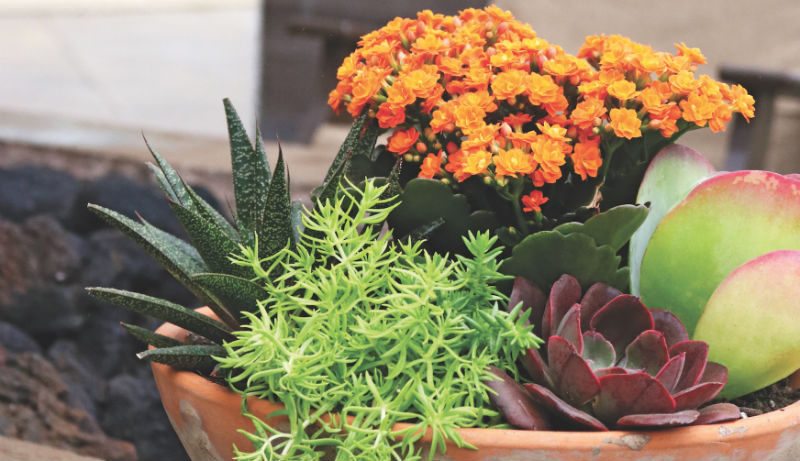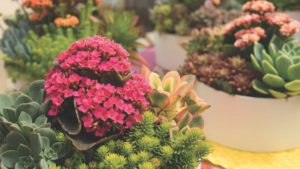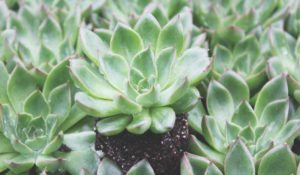
Succulent Combinations: Why and How
Succulents aren’t just a fad, they’re a highly lucrative opportunity that has been handed to our industry on a silver platter. This applies to suppliers, growers and retailers alike. Consumers are snatching them up as fast as we can get them on the shelves. To improve margins, encourage return business for retailers, and add value to a product that is swiftly becoming commoditized, succulent combinations are a low-effort choice to differentiate your production runs from the competition.
Every grower knows there are certain plants that simply don’t play well together. They may have beautifully contrasting blooms and complementing foliage, but the vigor and timing isn’t meant to be. This is anything but the case for most succulents. With few exceptions, succulent combinations can be grown with a highly diverse selection of plants. There’s no need to adhere to an all-echeveria or all-haworthia production plan; growers can mix-and- match different genera with ease.
Succulents achieve this adaptability with similar growth rates, similar finish sizes and the absence of bloom-time considerations. Adopting a “whatever is available” approach for succulent combos adds flexibility to production runs while simultaneously creating mixes that boast far better texture than a container comprised of one genus.
The appeal of diverse succulent combos can be raised to the next level by including drop-in cavities for flowering kalanchoes. Kalanchoes are the ideal plant to use as a drop-in because they hold the revered low-maintenance succulent status, with the added appeal of striking, colorful blooms. The seasonal décor potential for this concept is truly endless: a festive red kalanchoe drop-in during the holidays, pastel pink for Valentine’s Day, yellow for the sultry summer months, and a harvest orange accent in the autumn. This allows consumers to perceive succulent combinations as a focal point décor item that’s tailored to seasonality.

Growing Succulent Combos
Succulent combos aren’t just a concept, they are 100 percent executable for growers. Succulent combinations are ideally planted in 10-, 12- and 14- inch bowls with one central core item and four to nine succulents around the outside edge. The best way to execute this is by purchasing rooted cuttings and then transplanting them directly into the finish bowls.
With combinations in particular, starting with rooted liners can be an effective way to maximize production space. When starting with rooted liners, the space, time and effort required to root a succulent can be absorbed by a rooting station, giving growers great flexibility with bowl options. For the value-added flowering kalanchoe, pulling from existing inventory or timing kalanchoe crops specifically to plug into succulent combos are both feasible options. Be sure to place an empty pot in the center of the bowl before filling with media to accommodate the drop-in.
Although tough-as-nails in their natural habitats, succulents can be somewhat challenging to grow under intensely controlled environmental conditions. With a crop that prefers “benign neglect” as a culture strategy, it can be challenging not to hinder succulent growth with too much care. With that being said, there are certain practices that will almost certainly lead to a successful succulent crop.
Propagation
Sticking. If starting a succulent combo program from unrooted cuttings, a 50-cell liner is the ideal size to maintain a balance between media moisture, and the risk of rot and stretch. Although a typical well-drained, peat-based media can work for some growers, mixes with a greater quantity of perlite, sand, and/or pumice experience improved drainage, which can help to enhance the final quality of the crop.
Despite being sun-loving plants, succulents should not be stuck in direct sunlight. Similarly, avoid sticking in areas that experience wind or rapidly cycling air.
Moisture. After sticking, mist cuttings for one to two days to promote rooting and prevent desiccation of the exposed succulents. With rosette type succulents especially, a low-volume, high-frequency misting regimen will improve rooting.
Fertilizer and pH. Fertilize at 0- to 50-ppm nitrogen once roots emerge using a standard 10-10-10 NPK formulation. EC levels should be maintained around 0.6 to 0.9 by saturated media extraction (SME) to ensure proper feeding while limiting the risk of burn. All Dümmen Orange succulents can be grown in pH ranges of 5.8 to 6.2.
Temperature and light. The ideal media temperature is 68 to 75° F with air temperatures averaging 65 to 70° F. Upon stick, start shading when light levels surpass 4,000 foot-candles. Light levels and root development have a direct relationship; as rooting increases, so should light.
Timing. Dümmen Orange succulents are usually ready to transplant seven to nine weeks after stick if grown in a 50-cell liner.
Finishing
Pot sizes and timing.
Note: These projections vary by region; growers in northern climates will experience longer finish times while those in southern climates will experience shorter finish times. For quicker turns, consider planting additional liners in each bowl to decrease the amount expansion each succulent must experience before shipping.
Temperature.
Rooting-out day temperature: 70 to 75° F.
Rooting-out night temperature: 60 to 70° F.
Growing-on day temperature: 72 to 78° F.
Growing-on night temperature: 60 to 65° F.
Holding temperature: 55 to 65° F.

Succulents show their best color when grown under bright light, cool nights and dry conditions. If plants are produced in a greenhouse environment, it is beneficial to relocate plants outside one to two weeks prior to shipping.
Light. A daily light integral (DLI) of 30 to 50 mol·m−²·d−¹ is ideal and supplemental lighting should be considered when the DLI falls below 20 mol·m−²·d−¹. Although sun loving, shade should be considered when light levels surpass 6,000 foot-candles.
Watering. Allow soil media to dry significantly between waterings. Water early in the day to allow foliage to dry. Good circulation and humidity control is important for Botrytis, mildew and root rot management.
Fertilizer & pH. Apply 75- to 100-ppm nitrogen every third irrigation at 15-15-15 NPK with an EC range between 0.6 to 0.9 (SME). A finishing pH range of 5.8 to 6.2 is preferred.
Growth regulators. Plant growth regulators are not recommended during production as they will dramatically increase finish time. A paclobutrazol (0.4 percent) spray at 15 to 20 ppm before shipping will effectively prevent stretch during transport, at retail and in the consumer’s home. Growth regulators are not recommended for plants destined for the landscape market.



 Video Library
Video Library 




















